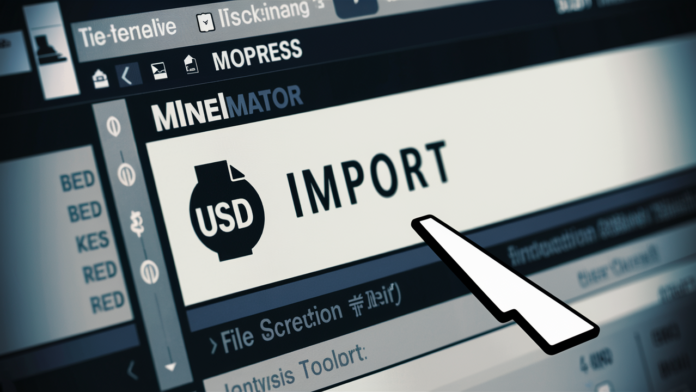If you’re a Minecraft fan who loves animation, Mine-Imator is your best friend. It’s a free and lightweight tool designed for creating animations using Minecraft-style assets. From simple character movements to full-blown cinematic sequences, Mine-Imator lets you bring blocky adventures to life.
Why Use USD Files in Mine-Imator Projects?
USD (Universal Scene Description) files are widely used in 3D animation and visual effects. Pixar developed them to manage complex scenes in a flexible, high-performance format. If you’ve got a fancy USD model from Blender, Maya, or another tool, you might want to bring it into Mine-Imator but it’s not always plug-and-play.
Understanding File Formats in Mine-Imator
Supported File Types
Mine-Imator supports formats like:
-
.miobject – native object format
-
.mimodel – for custom rigs
-
.obj/.dae – common 3D model formats
-
.png/.jpg – for textures
What is a USD File Format?
USD stands for Universal Scene Description. It can hold data for models, animations, shaders, cameras, and even lighting setups. It’s used heavily in studios and tools like:
-
Blender
-
Autodesk Maya
-
NVIDIA Omniverse
Differences Between .object, .miobject, and .usd
-
.miobject/.mimodel – Designed for Mine-Imator; easy to import
-
.usd – Not directly supported, often too complex without conversion
Can Mine-Imator Import USD Files Natively?
Native Format Compatibility
Currently (as of 2025), Mine-Imator does NOT natively support USD files. Trying to drag and drop a .usd file into the interface? Won’t work.
Limitations with USD Files
USD files are packed with advanced data way more than Mine-Imator is designed to handle. This includes:
-
Node hierarchies
-
Complex shaders
-
Embedded materials
Workarounds and Third-Party Tools
To make it work, you’ll need to convert the USD file to a supported format like .OBJ or .DAE, which we’ll walk through next.
Step-by-Step Guide to Importing USD Files
Step 1: Convert USD to OBJ or DAE
Use Blender or a USD viewer to open the .usd file and export it in a more Mine-Imator-friendly format.
Step 2: Import into Blender (if needed)
Blender 3.0+ has native support for USD files.
-
Open Blender
-
Go to
File > Import > Universal Scene Description (.usd) -
Select your file
-
Make necessary adjustments
Step 3: Export to a Mine-Imator Compatible Format
Once the model is clean in Blender:
-
Go to
File > Export > Wavefront (.obj)orCollada (.dae) -
Name the file
-
Choose Apply Transformations
-
Click Export
Step 4: Import into Mine-Imator
-
Open Mine-Imator
-
Create a new project
-
Click
Import > Model > .obj/.dae -
Adjust scaling and textures as needed
Done!
Using Blender to Convert USD Files
Installing Blender
Download the latest version of Blender from blender.org. It’s free and works on Windows, Mac, and Linux.
Importing USD into Blender
-
Open Blender
-
Go to
File > Import > USD -
Load your model
-
Check the outliner for structure
Exporting from Blender as .OBJ or .DAE
After cleaning the model:
-
Delete unnecessary parts
-
Simplify geometry
-
Export as
.objfor best compatibility
Using External Tools for Conversion
Autodesk USD Viewer
This free tool by Autodesk lets you preview USD files and sometimes convert them to FBX or OBJ.
Online File Converters (Pros and Cons)
Pros:
-
Quick and easy
-
No need to install software
Cons:
-
File size limits
-
May break complex meshes
-
Risky if using sensitive assets
Recommended converters: AnyConv, Meshconvert, Aspose
Tips for a Smooth Import
Clean Up Geometry Before Export
Simplify the model in Blender before exporting. Fewer faces = smoother performance.
Reduce Polygon Count for Performance
Mine-Imator doesn’t handle ultra-detailed meshes well. Use Blender’s Decimate Modifier to optimize.
Texture Handling Tips
Make sure to:
-
Use simple PNGs or JPGs
-
Check UV mapping
-
Rename textures clearly
Fixing Common Import Issues
Missing Textures
-
Ensure texture paths are relative, not absolute
-
Keep textures in the same folder as the model
Broken Mesh or Misaligned Parts
-
Apply all transforms in Blender (
Ctrl + A > All Transforms) -
Export with “Apply Modifiers” checked
Unsupported Features
Some features (like shaders or rigged bones) won’t translate. Stick to basic mesh + texture for best results.
Alternatives to USD for Mine-Imator Projects
Use .OBJ or .MIObject Instead
If you have access to the original model in .OBJ, use it directly. It’s way easier than converting from USD.
Community Resources for Models
Check out:
-
Mine-Imator Forums
-
MC Models Resource
-
Sketchfab (search Minecraft-related assets)
Frequently Asked Questions About USD and Mine-Imator
Is There a Plugin to Import USD?
Not yet. As of 2025, no official Mine-Imator plugin supports USD. Blender remains your best bridge.
Will Mine-Imator Add Native USD Support?
There’s no public roadmap hinting at this. For now, stick to conversion workflows.
Conclusion
Importing USD files into Mine-Imator might sound like a headache, but with the right tools (hello, Blender), it’s totally doable. Whether you’re an animator creating Minecraft stories or a content creator using advanced models, knowing how to convert and import properly saves time and frustration. So next time someone sends you a USD model, don’t panic just convert, clean up, and get animating.
FAQs
1. What is the best file format to use in Mine-Imator?
.miobject and .obj are your best bets for stability and compatibility.
2. Can I import rigged models into Mine-Imator?
You can import them, but the rigging may not transfer unless it’s done inside Mine-Imator.
3. How do I fix texture problems when importing?
Make sure your texture paths are correct, and use standard formats like PNG or JPG.
4. Are there limits on model file size in Mine-Imator?
Large files can cause lag. Try to keep your models optimized and under 20MB if possible.
5. Can I animate USD models in Blender before importing?
Yes, but Mine-Imator won’t recognize the animations. You’ll need to reanimate in Mine-Imator after import.


